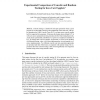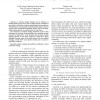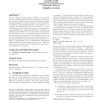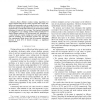CORR
2011
Springer
13 years 11 months ago
2011
Springer
Software testing is an expensive process, which is vital in the industry. Construction of the test-data in software testing requires the major cost and to decide which method to us...
COMPSAC
2010
IEEE
14 years 2 months ago
2010
IEEE
An important goal of automatic testing techniques, including random testing is to achieve high code coverage with a minimum set of test cases. To meet this goal, random testing res...
SPIN
2010
Springer
14 years 2 months ago
2010
Springer
Concolic testing is a method for test input generation where a given program is executed both concretely and symbolically at the same time. This paper introduces the LIME Concolic ...
JSS
2010
14 years 3 months ago
2010
Random testing is not only a useful testing technique in itself, but also plays a core role in many other testing methods. Hence, any significant improvement to random testing ha...
ICST
2010
IEEE
14 years 3 months ago
2010
IEEE
—A random testing strategy can be effective at finding faults, but may leave some routines entirely untested if it never gets to call them on objects satisfying their preconditi...
ISSTA
2007
ACM
14 years 6 months ago
2007
ACM
Progress in testing requires that we evaluate the effectiveness of testing strategies on the basis of hard experimental evidence, not just intuition or a priori arguments. Random ...
EMSOFT
2008
Springer
14 years 6 months ago
2008
Springer
The Simulink/Stateflow (SL/SF) environment from Mathworks is becoming the de facto standard in industry for model based development of embedded control systems. Many commercial to...
AADEBUG
2005
Springer
14 years 6 months ago
2005
Springer
In a C compiler, function calls are difficult to implement correctly because they must respect a platform-specific calling convention. But they are governed by a simple invariant...
COMPSAC
2009
IEEE
14 years 7 months ago
2009
IEEE
—Many efficient random testing algorithms for object-oriented software have been proposed due to their simplicity and reasonable code coverage; however, even the stateof-the-art...
GECCO
2006
Springer
14 years 8 months ago
2006
Springer
Adaptive Random Testing subsumes a class of algorithms that detect the first failure with less test cases than Random Testing. The present paper shows that a "reference metho...




